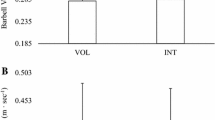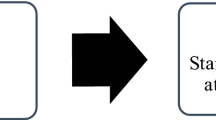Abstract
Purpose
This study explored the acute effects of strength-oriented resistance training sessions performed using three different set configurations on barbell velocity and the force–velocity (F–v) relationship of upper-body muscles in men and women.
Method
Thirteen men (age: 23.8 ± 2.5 years; 6-repetition maximum [6RM] load: 73.4 ± 15.6 kg) and 13 women (age: 21.5 ± 1.4 years; 6RM load: 32.8 ± 5.2 kg) performed 24 repetitions with a 6RM load during the bench press exercise using traditional (TR: 6 sets of 4 repetitions with 3 min of rest between sets), cluster (CL: 6 sets of 4 repetitions with 15 s of intra-set rest every two repetitions and 2 min and 45 s of rest between sets) and inter-repetition rest (IRR: 1 set of 24 repetitions with 39 s of rest between repetitions) set configurations. The F–v relationship parameters [maximum force (F0), maximum velocity (v0) and maximum power (Pmax)] were determined before and after each training session.
Results
The average training velocity did not differ between the three set configurations (p = 0.234), but the IRR set configuration generally provided higher velocities during the last repetition of each set. Significant decreases in F0 (p = 0.001) and Pmax (p = 0.024) but not in v0 (p = 0.669) were observed after the training sessions. Comparable velocity loss was observed for men and women (− 12.1% vs. − 11.3%; p = 0.699).
Conclusions
The administration of very short intra-set rest periods does not allow for the attainment of higher velocities than traditional set configurations during strength-oriented resistance training sessions conducted with the bench press exercise when the work-to-rest ratio is equated.



Similar content being viewed by others
Abbreviations
- TR:
-
Traditional set configuration
- CL:
-
Cluster set configuration
- IRR:
-
Inter-repetition rest set configuration
- 1 RM:
-
One repetition maximum
- F–v:
-
Force–velocity
- F 0 :
-
Maximal theoretical force
- v 0 :
-
Maximal theoretical velocity
- P max :
-
Maximal theoretical power
- ES:
-
Effect size
- SD:
-
Standard deviation
References
Bogdanis GC, Nevill ME, Lakomy HK, Boobis LH (1998) Power output and muscle metabolism during and following recovery from 10 and 20 s of maximal sprint exercise in humans. Acta Physiol Scand 163:261–272. https://doi.org/10.1046/j.1365-201x.1998.00378.x
Chiu LZF, Fry AC, Weiss LW et al (2003) Postactivation potentiation response in athletic and recreationally trained individuals. J Strength Cond Res 17:671–677. https://doi.org/10.1519/1533-4287(2003)017%3c0671:PPRIAA%3e2.0.CO;2
Clark BC, Manini TM, The DJ et al (2003) Gender differences in skeletal muscle fatigability are related to contraction type and EMG spectral compression. J Appl Physiol 94:2263–2272. https://doi.org/10.1152/japplphysiol.00926.2002
Davies RW, Carson BP, Jakeman PM (2018) Sex differences in the temporal recovery of neuromuscular function following resistance training in resistance trained men and women 18 to 35 years. Front Physiol 9:1480. https://doi.org/10.3389/fphys.2018.01480
Filho JCJ, Gobbi LTB, Gurjao ALD et al (2013) Effect of different rest intervals, between sets, on muscle performance during leg press exercise, in trained older women. J Sports Sci Med 12:138–143 (In press)
García-Ramos A, Jaric S (2018) Two-point method: a quick and fatigue-free procedure for assessment of muscle mechanical capacities and the one-repetition maximum. Strength Cond J 40:54–66. https://doi.org/10.1519/SSC.0000000000000359
García-Ramos A, Padial P, Haff GG et al (2015) Effect of different interrepetition rest periods on barbell velocity loss during the ballistic bench press exercise. J Strength Cond Res 29:2388–2396. https://doi.org/10.1519/JSC.0000000000000891
García-Ramos A, González-Hernández JM, Baños-Pelegrín E et al (2017) Mechanical and metabolic responses to traditional and cluster set configurations in the bench press exercise. J strength Cond Res. https://doi.org/10.1519/jsc.0000000000002301 (In press)
García-Ramos A, Torrejón A, Feriche B et al (2018a) Selective effects of different fatigue protocols on the function of upper body muscles assessed through the force–velocity relationship. Eur J Appl Physiol 118:439–447. https://doi.org/10.1007/s00421-017-3786-7
García-Ramos A, Torrejón A, Feriche B et al (2018b) Prediction of the maximum number of repetitions and repetitions in reserve from barbell velocity. Int J Sports Physiol Perform 13:353–359. https://doi.org/10.1123/ijspp.2017-0302
Girman JC, Jones MT, Matthews TD, Wood RJ (2014) Acute effects of a cluster-set protocol on hormonal, metabolic and performance measures in resistance-trained males. Eur J Sport Sci 14:151–159. https://doi.org/10.1080/17461391.2013.775351
González-Badillo JJ, Rodríguez-Rosell D, Sánchez-Medina L et al (2014) Maximal intended velocity training induces greater gains in bench press performance than deliberately slower half-velocity training. Eur J Sport Sci 18:772–781. https://doi.org/10.1080/17461391.2014.905987
González-Hernández J, García-Ramos A, Capelo-Ramírez F et al (2017) Mechanical, metabolic, and perceptual acute responses to different set configurations in full squat. J Strength Cond Res. https://doi.org/10.1519/jsc.0000000000002117 (In press)
Haff GG, Whitley A, McCoy LB et al (2003) Effects of different set configurations on barbell velocity and displacement during a clean pull. J Strength Cond Res 17:95–103. https://doi.org/10.1519/1533-4287(2003)017%3c0095:EODSCO%3e2.0.CO;2
Haff GG, Hobbs RT, Haff EE et al (2008) Cluster training: a novel method for introducing training program variation. Strength Cond J. 30:67–76. https://doi.org/10.1519/SSC.0b013e31816383e1
Hansen KT, Cronin JB, Newton MJ (2011) The effect of cluster loading on force, velocity, and power during ballistic jump squat training. Int J Sports Physiol Perform 6:455–468. https://doi.org/10.1123/ijspp.6.4.455
Hopkins WG, Marshall SW, Batterham AM, Hanin J (2009) Progressive statistics for studies in sports medicine and exercise science. Med Sci Sports Exerc 41:3–13. https://doi.org/10.1249/MSS.0b013e31818cb278
Iglesias-Soler E, Carballeira E, Sánchez-Otero T et al (2012) Acute effects of distribution of rest between repetitions. Int J Sports Med 33:351–358. https://doi.org/10.1055/s-0031-1299699
Iglesias-Soler E, Carballeira E, Sánchez-Otero T et al (2014) Performance of maximum number of repetitions with cluster-set configuration. Int J Sports Physiol Perform 9:637–642. https://doi.org/10.1123/IJSPP.2013-0246
Jaric S (2015) Force-velocity relationship of muscles performing multi-joint maximum performance tasks. Int J Sports Med 36:699–704. https://doi.org/10.1055/s-0035-1547283
Koefoed N, Lerche M, Jensen B et al (2018) Peak power output in loaded jump squat exercise is affected by set structure. Int J Exerc Sci 11:776–784
Korak JA, Paquette MR, Fuller DK et al (2018) Effect of a rest-pause vs. traditional squat on electromyography and lifting volume in trained women. Eur J Appl Physiol 118:1309–1314. https://doi.org/10.1007/s00421-018-3863-6
Marshall PWM, McEwen M, Robbins DW (2011) Strength and neuromuscular adaptation following one, four, and eight sets of high intensity resistance exercise in trained males. Eur J Appl Physiol 111:3007–3016. https://doi.org/10.1007/s00421-011-1944-x
McGuigan MR, Wright GA, Fleck SJ (2012) Strength training for athletes: does it really help sports performance? Int J Sports Physiol Perform 7:2–5
Moreno SD, Brown LE, Coburn JW, Judelson DA (2014) Effect of cluster sets on plyometric jump power. J strength Cond Res 28:2424–2428. https://doi.org/10.1519/JSC.0000000000000585
Oliver JM, Kreutzer A, Jenke S et al (2015) Acute response to cluster sets in trained and untrained men. Eur J Appl Physiol 115:2383–2393. https://doi.org/10.1007/s00421-015-3216-7
Oliver JM, Jenke SC, Mata JD et al (2016) Acute effect of cluster and traditional set configurations on myokines associated with hypertrophy. Int J Sports Med 37:1019–1024. https://doi.org/10.1055/s-0042-115031
Pareja-Blanco F, Rodriguez-Rosell D, Sanchez-Medina L et al (2014) Effect of movement velocity during resistance training on neuromuscular performance. Int J Sports Med 35:916–924
Pareja-Blanco F, Rodríguez-Rosell D, Sánchez-Medina L et al (2017) Effects of velocity loss during resistance training on athletic performance, strength gains and muscle adaptations. Scand J Med Sci Sport 27:724–735. https://doi.org/10.1111/SMS.12678
Pestaña-Melero F, Haff GGG, Rojas FJF et al (2017) Reliability of the load-velocity relationship obtained through linear and polynomial regression models to predict the one-repetition maximum load. J Appl Biomech 34:184–190. https://doi.org/10.1123/jab.2017-0266
Pincivero DM, Coelho AJ, Campy RM (2004) Gender differences in perceived exertion during fatiguing knee extensions. Med Sci Sports Exerc 36:109–117. https://doi.org/10.1249/01.MSS.0000106183.23941.54
Rahmani A, Samozino P, Morin J-B, Morel B (2018) A Simple method for assessing upper-limb force–velocity profile in bench press. Int J Sports Physiol Perform 13:200–207. https://doi.org/10.1123/ijspp.2016-0814
Seitz LB, de Villarreal ES, Haff GG (2014) The temporal profile of postactivation potentiation is related to strength level. J strength Cond Res 28:706–715. https://doi.org/10.1519/JSC.0b013e3182a73ea3
Suchomel TJ, Nimphius S, Stone MH (2016) The importance of muscular strength in athletic performance. Sport Med 46:1419–1449. https://doi.org/10.1007/s40279-016-0486-0
Torrejon A, Balsalobre-Fernandez C, Haff GG, Garcia-Ramos A (2018) The load-velocity profile differs more between men and women than between individuals with different strength levels. Sport Biomech. https://doi.org/10.1080/14763141.2018.1433872
Tufano JJ, Conlon JA, Nimphius S et al (2016) Maintenance of velocity and power with cluster sets during high-volume back squats. Int J Sports Physiol Perform 11:885–892. https://doi.org/10.1123/ijspp.2015-0602
Tufano JJ, Brown LE, Haff GG (2017a) Theoretical and practical aspects of different cluster set structures: a systematic review. J Strength Cond Res 31:848–867. https://doi.org/10.1519/JSC.0000000000001581
Tufano JJ, Conlon JA, Nimphius S et al (2017b) Cluster sets: permitting greater mechanical stress without decreasing relative velocity. Int J Sports Physiol Perform 12:463–469. https://doi.org/10.1123/ijspp.2015-0738
Tufano JJ, Conlon JA, Nimphius S et al (2017c) Different cluster sets result in similar metabolic, endocrine, and perceptual responses in trained men. J Strength Cond Res 33:346–354. https://doi.org/10.1519/JSC.0000000000001898
Winter DA (1990) Biomechanics and motor control of human movement. Wiley, Hoboken, pp 165–189
Acknowledgements
We would like to thank all subjects that voluntary participated in this study.
Author information
Authors and Affiliations
Contributions
AT, AGR and GGH conceived and designed research. AT and AGR collected data. AT, DJ, and AGR organized the database and performed the statistical analysis. AT and AGR wrote the first draft of the manuscript. All authors contributed to manuscript revision, read and approved the submitted version.
Corresponding author
Ethics declarations
Conflict of interest
The authors declare that they have no conflict of interest.
Additional information
Communicated by Toshio Moritani.
Publisher's Note
Springer Nature remains neutral with regard to jurisdictional claims in published maps and institutional affiliations.
Rights and permissions
About this article
Cite this article
Torrejón, A., Janicijevic, D., Haff, G.G. et al. Acute effects of different set configurations during a strength-oriented resistance training session on barbell velocity and the force–velocity relationship in resistance-trained males and females. Eur J Appl Physiol 119, 1409–1417 (2019). https://doi.org/10.1007/s00421-019-04131-8
Received:
Accepted:
Published:
Issue Date:
DOI: https://doi.org/10.1007/s00421-019-04131-8




